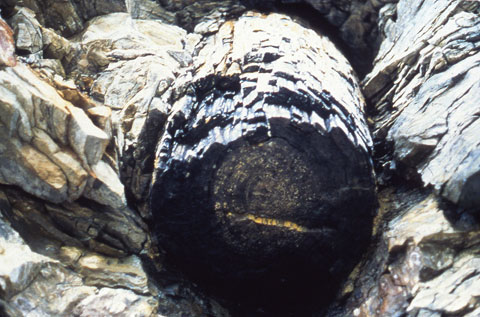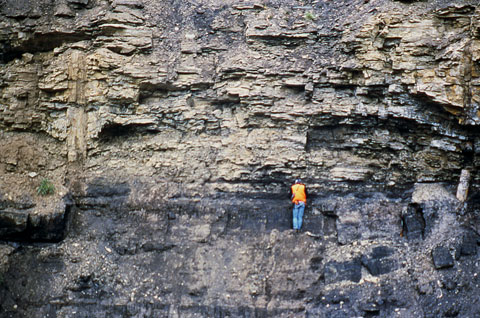The Lost World of the Arctic
| A Warm Arctic | Climate Change | Polar Light Regime | Arctic Forests | Arctic Dinosaurs |
|---|
Arctic Forests
|
Fossil Wood - The Lili Creek 'Forest'
In 1996 six large trees were found preserved in their upright growth position in the Late Albian- early Cenomanian Corwin Formation, Nanushuk Group, exposed along Lili Creek, North Slope, Alaska 69.3218 °N, -158.1876 °W). The surviving parts of the trees measured 0.1 - 0.7 m in diameter and up to 4.5 m in height. They appear rooted in the underlying coal/carbonaceous shale unit that measures 9 m in thickness, but are entombed in an upward coarsening succession of sandstones (Decker et al. 1997). The transition from the coal to the sandstones is gradational. The uppermost part of the coaly unit is a carbonaceous shale grading into dark olive gray to black carbonaceous mudstone and siltstone, lenticular bedded fine to medium grained sandstone. The succession is interpreted to be the result of the introduction of crevasse splay sediments into a poorly-drained backswamp.
|
 |
 |
|
|---|---|---|
 |
Top Left: Lili Creek exposure showing a 9 m thick coal/carbonaceous shale unit that appears to be the rooting horizon for the trees. Top Right: Detail of the cross section of the tree shown at the right of the images at the Top Right Left and Bottom Left. Bottom Right: Detail of the Lili Creek section showing two upright trres. Move the cursor over the image to see the trees highlighted. Bottom Left: Detail of the tree impression shown on the left of the Bottom Right image. All photographs by Greg Wilson, ARCO and supplied by Gil Mull. |
|
|---|---|---|
|
The trees are preserved as both impressions in the sandstone face or as three dimensional partially permineralised logs, both upright and horizontal. Growth rings are clearly visible in some specimens. The tallest trees are truncated at the same sandstone horizon that occurs at 5.5 m above the coal (as distinct from the carbonaceous shale) top. The size and taper of the trees suggest that in life they were likely to have been at least 15 m tall and evidently the trunks were straight and not highly divided. The preservation of trees in their upright growth position is not unusual in northern Alaska, but these specimens are exceptional in terms of their height and is a testament to locally high rates of sediment deposition. Other examples can be found along the Kukpowruk River at locality 96-19. Fallen logs are also abundant such as at Kukpowruk River locality 96-20. |
||

